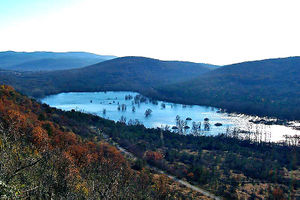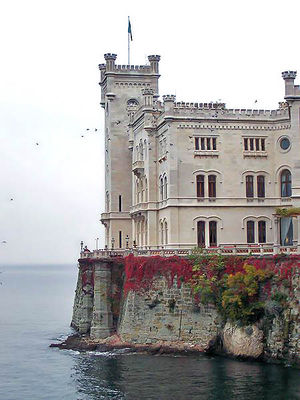Difference between revisions of "Friuli-Venezia Giulia"
m |
m |
||
| Line 48: | Line 48: | ||
| − | |||
| − | + | '''Friuli-Venezia Giulia''' ([[Friulian]]: ''Friûl-Vignesie Julie'', {{lang-de|Friaul-Julisch Venetien}}, {{lang-sl|Furlanija - Julijska krajina}}, {{lang-vec|Friul-Venèthia Jułia}}) is one of the twenty [[regions of Italy]], and one of five [[autonomous regions with special statute]]. The capital is [[Trieste]]. It has an area of 7,856 km² and about 1.2 million inhabitants. A natural opening to the sea for many [[Central Europe]]an countries, the region is traversed by the major transport routes between the east and west of southern Europe. It encompasses two historical regions, each own with its distinct identity: [[Friuli]] and [[Venezia Giulia]]. | |
| − | |||
| − | Friuli-Venezia Giulia is divided into four provinces: | + | == Geography == |
| + | |||
| + | Friuli-Venezia Giulia is Italy's most North-eastern region. It covers an area of 7,856 km2 and is the fifth smallest region of the country. It borders [[Austria]] to the North and [[Slovenia]] to the East; to the South it faces the [[Adriatic Sea]]. | ||
| + | |||
| + | Despite its relatively small dimension, the region boasts a wide variety of climates and landscapes (as well as cultures and traditions). 42.5% of its surface is made up by mountains, 19.3% by hills and the remaining 38.2% by the plains situated in the central areas and along the coast. | ||
| + | |||
| + | [[File:Culino.JPG|thumb|left|A view of the [[Carnia]] subregion.]] | ||
| + | |||
| + | Morphologically the region can be divided into four main areas: | ||
| + | |||
| + | - the mountainous area in the north: this part of the region includes [[Carnia]] and the ending section of the [[Alps]] ([[Carnic Alps]] and [[Julian Alps]]), of which the highest peaks exceed 2,700 m above sea level ([[Jôf di Montasio]] 2,754 m.). Its landscapes are characterised by vast pine forests and pastures, mountain lakes (e.g. [[Sauris]] and [[Barcis]]) and numerous streams and small rivers descending from the mountains. The area is also known for its tourist destinations, especially during the winter season; | ||
| + | - the hilly area, situated to the south of the mountains and along the central section of the border with [[Slovenia]]. The main product of agriculture in this area is definitely wine, whose quality, especially the white, is known worldwide; | ||
| + | - the central and upper plains are characterised by poor, arid and permeable soil which, however, has been made fertile with an extensive irrigation system and through the adoption of new intensive farming techniques. In this part of the region most of the agricultural activities are concentrated; | ||
| + | - the coastal area can be divided in two sections, separated by the mouth of the river [[Isonzo]]. To the West, the low, sandy coast, with numerous tourist resorts and the lagoons of [[Grado, Italy|Grado]] and [[Marano Lagunare]]; to the East the coastline becomes high and rocky all the way to Trieste and Muggia. Along this part of the coast the Carso plateau is situated. It extends over the provinces of Trieste and Gorizia, at an average altitude of 400 to 600 metres above sea level and is characterised by very specific geological features and phenomena. | ||
| + | |||
| + | [[File:Karst italy doberdo lake.jpg|thumb|left|[[Karst]] landscape at [[Doberdò del Lago|Doberdò]].]] | ||
| + | The rivers of the region flow from the North and from Slovenia into the [[Adriatic]]. The two main rivers are the [[Tagliamento]], which divides the [[Alps]] from the less high [[Alpine foothills]], and the [[Isonzo]]. Another river of interest is the [[Timavo]], which flows underground for 38 km from [[Slovenia]] and resurfaces near its mouth in [[Duino]]. | ||
| + | |||
| + | The region Friuli-Venezia Giulia has a temperate climate. However, due to the diversity of its territory, it varies considerably from one area to another. Protected by the [[Alps]] on the northern side, the region is exposed to air masses from the East and the West. The region is also open to the winds from the sea (scirocco), bringing with them heavy rainfalls. Along the coast the climate is mild and pleasant ([[Triest]] records the smallest temperature differences between winter and summer and between day and night), but becomes more continental in the mountain area, where, in some locations, the coldest winter temperatures in Italy can often be found. The [[Kras]] plateau has its own weather and climate, influenced, mostly during autumn and winter, by masses of cold air coming from the North-East. These generate a very special feature of the local climate: the north-easterly wind [[Bora]], which blows over the [[Gulf of Trieste]] with gusts occasionally exceeding speeds of 150 km/h. | ||
| + | |||
| + | == History == | ||
| + | |||
| + | : ''Main articles: [[Friuli#History|History of Friuli]] and [[Venezia Giulia#History|History of Venezia Giulia]]'' | ||
| + | {{See also|Gorizia and Gradisca|Austrian Littoral}} | ||
| + | |||
| + | [[File:Foro romano di Aquileia.jpg|thumb|left|Roman ruins in [[Aquileia]].]] | ||
| + | |||
| + | The traces of a common "Roman origin" are quite visible over all the territory, and the unifying element of the two parts is the [[Italia (Roman Empire)|X Regio Venetia et Histria]], with its capital at [[Aquileia]] in the [[Emperor Augustus|Augustan]] period. Starting from the [[Longobard]] settlements (6th century), the historical paths diverge and become particularized: [[Cividale del Friuli]] – the Roman [[Forum Iulii]] (from which the name Friuli comes) – became the capital of the first [[Longobard]] Dukedom in Italy; the [Franks], arriving a couple of centuries later, favoured the growth of the church of [[Aquileia]]; the patriarchal feudal state, which was created in 1077, held both religious and temporal power and this was extended temporarily even to the east, but already in the 12th century [[Gorizia]] had actually become independent and [[Trieste]], along with other coastal towns, organized itself as a free city-state. | ||
| + | |||
| + | [[File:Castello di Miramare lato mare.JPG|thumb|right|[[Miramare Castle]], built by Archiduke [[Maximilian I of Mexico|Maximilain of Austria]] in [[Trieste]].]] | ||
| + | |||
| + | It was the Fatherland of Friuli that became [[Republic of Venice|Venetian]] territory in 1420, while Trieste and Gorizia remained under the [[Austrian Empire]]. Pordenone was a "corpus separatum", under Austrian influence until 1515, when it fell under the domination of Venice, too. With the peace treaty of Campoformido in 1797, Venetian domination came to an end and Friuli was ceded to Austria. After the period of domination by [[Napoleon]], which affected also Trieste and Gorizia, it again became part of the Austrian Empire and was included in the Lombard-Veneto Kingdom, while Gorizia was merged with the Illyrian Kingdom and Trieste, together with Istria, became part of the Austrian Coastal Region. The enlightened policy of the [[Austrian-Hungarian Empire]] in the 18th and 19th centuries encouraged an extraordinary economic flourishing, making Trieste the empire’s port. The fortunate outcome of the war of independence brought Friuli alone into the unified Kingdom of Italy. | ||
| + | After the [[First World War]], in which this region was a main theatre of operations, and suffered very serious damage and loss of lives, the fates of these border lands were again united, although [[Venezia Giulia]], in particular, underwent very painful experiences due to the explosion of contradictions regarding the borders. | ||
| + | |||
| + | The [[Second World War]], once again very dearly paid for, led to the [[Free Territory of Trieste|Anglo-American Administration in Trieste]] until the border was fixed with the Memorandum of London in 1954. When Trieste was reunited with Italy, the Autonomous Region of Friuli Venezia Giulia could finally be established. The Italian Constitution assigns it the status of Region with a Special Statute, together with four other Italian regions. However, Friuli Venezia Giulia obtained administrative autonomy and the special statute only in 1963. The reasons for this "constitutional delay" are interwoven with the international problems of the second postwar period and with those deriving from the region’s "diversity" – the different historical, ethnic, and linguistic components that go to make up this area. In 1975 the [[Treaty of Osimo]] was signed in [[Osimo]], definitively dividing the former [[Free Territory of Trieste]] between [[Italy]] and [[Yugoslavia]]. | ||
| + | |||
| + | == Economy == | ||
| + | {{See also|Friuli-Venezia Giulia wine}} | ||
| + | |||
| + | [[File:Refosco dal Peduncolo bottle.jpg|thumb|right|A bottle of ''[[Refosco]]''. Friuli is famous for its wines. ]] | ||
| + | |||
| + | The economy of Friuli-Venezia Giulia is one of the most developed in the country. Its core is based on small- and middle-size enterprises (the so-called 'North-East model'), on specialised farming and on high-quality tourism with a significant inclination towards exports. | ||
| + | |||
| + | Agriculture and farming maintain an essential role in the economy of the region and employed in 2001 around 95,000 persons. Its high quality products are exported not only within the country and Europe (fruit and vegetable, cheese) but have become known worldwide for their quality (cured ham and wines, especially white ones). Noteworthy is also the production of soy (third producer in Italy with more than 37,000 hectares cultivated in 2000) and timber production in [[Carnia]]. | ||
| + | |||
| + | As mentioned above, the economy of the region is based on a widespread mosaic of small and medium-size enterprises; of particular importance are the four industrial districts where a multitude of such highly specialised enterprises are concentrated. These districts are centred around the towns of [[Manzano]] (accounting for the production of 30% of chairs in the world), [[San Daniele del Friuli]] (cured ham), [[Maniago]] (knives) and [[Brugnera]] (furniture). A number of large enterprises are also present in the region in both the industry and services sector. Some of these companies are world-leaders in their relevant sectors; such are [[Fincantieri]] (based in [[Trieste]] and in [[Monfalcone]]) for the construction of the world's largest cruise ships, [[Zanussi]]-[[Electrolux]] ([[Pordenone]]) in the production of electrical appliances and [[Assicurazioni Generali]] in [[Trieste]], one of the leading insurance companies in the world. | ||
| − | + | Again, in the services sector the city of [[Trieste]] plays a leading role (with knock-on effects on the other provincial capitals); it is in fact here that activities such as the regional government, large banking and insurance companies are concentrated. With its commercial Free Port, Trieste also plays an essential role in the trade sector: special custom regulations ensure exclusive financial conditions to operators. The Port of Trieste is today the most important centre worldwide for the trade of coffee and plays a strategic key role in trade with northern and eastern Europe. | |
| − | |||
| − | |||
| − | |||
| − | |||
| − | + | [[File:Porttrieste old.jpg|thumb|right|The port of [[Trieste]].]] | |
| − | |||
| − | |||
| − | + | Although small in size, Friuli-Venezia Giulia has always been 'in the centre of Europe' and has played an important role in connecting Italy (and the Mediterranean) to Central and Eastern Europe. Its role will become even more strategic as a logistical platform with the imminent enlargement of the European Union. Hence the importance of the infrastructure network of the region, which can today be considered first rate in quality and diversity. The motorway network consists of more than 200 km that run from North to South and from West to East, perfectly connecting the region to [[Austria]] and [[Slovenia]]. The railway network consists of around 500 km of track, with the two twin-line 'backbones' Venice-Trieste and Trieste-Udine-Tarvisio-Austria. The motorway and railway networks are linked to the ports of Trieste, Monfalcone and Porto Nogaro, the three most northerly ports of the Mediterranean. Trieste, in particular, has a free port for goods since 1719. It is the Italian port with the greatest capacity for covered storage, with a surface area of more than 2 million square meters and 70 km of rail tracks. Intermodality is guaranteed by the [Cervignano] terminal, in operation since 1988, to serve the increasing commercial traffic between Italy and Eastern European countries. Lastly, the regional airport of [[Ronchi dei Legionari]] is situated 30 km from Trieste and 40 km from Udine and is closely connected to the motorway and railway networks. The airport offers regular national and international flights including destinations in Eastern Europe. The region is now placing much of its hopes for future economic development in the construction of a high speed [[Pan-European corridors|European Transport Corridor n° V]] connecting Lion, Turin, Venice, Trieste, Ljubljiana, Budapest and Kiev, so as to improve the traffic of goods and services with new EU partners. | |
| − | |||
| − | == | + | == Demographics == |
| + | {{Historical populations | ||
| + | |type = | ||
| + | |footnote = Source: [[ISTAT]] 2001 | ||
| + | |1871 |508000 | ||
| + | |1881 |530000 | ||
| + | |1901 |615000 | ||
| + | |1911 |728000 | ||
| + | |1921 |1178000 | ||
| + | |1931 |1176000 | ||
| + | |1936 |1108000 | ||
| + | |1951 |1226000 | ||
| + | |1961 |1204000 | ||
| + | |1971 |1214000 | ||
| + | |1981 |1234000 | ||
| + | |1991 |1198000 | ||
| + | |2001 |1184000 | ||
| + | |2008 (Est.) | ||
| + | |1230000}} | ||
| − | + | Population density is lower than the national average; in 2008 it was in fact equal to 157.5 inhabitants per km2 (compared to 198.8 for Italy as a whole). However, density varies from a minimum of 106 inhabitants per km2 in the province of Udine to a maximum of 1,144 inhabitants per km2 in the province of Trieste. | |
| + | The negative natural balance in the region is partly made up by the positive net migration. To some extent the migratory surplus has in fact offset the downward trend in the population since 1975. In 2008, the resident population with foreign nationality registered in the region accounted to 83,306 persons (6.7% of the total population). | ||
| − | == | + | === Language === |
Apart from Italian, the [[Friulian language]] is spoken in most of the region — with a few exceptions, most notably [[Triestine language|Trieste]]; there is also a sizeable [[Slovenians|Slovenian]] and a small German minority. | Apart from Italian, the [[Friulian language]] is spoken in most of the region — with a few exceptions, most notably [[Triestine language|Trieste]]; there is also a sizeable [[Slovenians|Slovenian]] and a small German minority. | ||
| − | The [[Slovenian language]] is spoken throughout the [[province of Trieste]], as well as in the eastern parts of the provinces of Gorizia and Udine and in the area called [[Venetian Slovenia]], which comprises the [[Resia]] Valley and in the upper valleys of the rivers [[Torre River|Torre]] and [[Natisone]], with many villages having both Italian and Slovenian names. The number of Slovenes in the region is 61 000. | + | The [[Slovenian language]] is spoken throughout the [[province of Trieste]], as well as in the eastern parts of the provinces of Gorizia and Udine and in the area called [[Venetian Slovenia]], which comprises the [[Resia]] Valley and in the upper valleys of the rivers [[Torre River|Torre]] and [[Natisone]], with many villages having both Italian and Slovenian names. The number of Slovenes in the region is 61,000. |
The number of native German speakers in Friuli-Venezia Giulia is estimated to be around 2,000. They live in the [[Val Canale]] (municipalities of [[Tarvisio]], [[Malborghetto Valbruna]] and [[Pontebba]]), which is adjacent to Austria, and in the municipality of [[Sauris]] and the ''frazione'' of [[Timau]] (''Tischlbong'' in the local Germanic language) (municipality of [[Paluzza]]), which each form a language exclave. | The number of native German speakers in Friuli-Venezia Giulia is estimated to be around 2,000. They live in the [[Val Canale]] (municipalities of [[Tarvisio]], [[Malborghetto Valbruna]] and [[Pontebba]]), which is adjacent to Austria, and in the municipality of [[Sauris]] and the ''frazione'' of [[Timau]] (''Tischlbong'' in the local Germanic language) (municipality of [[Paluzza]]), which each form a language exclave. | ||
| − | + | == Government and politics == | |
| + | {{main|Politics of Friuli-Venezia Giulia}} | ||
| + | |||
| + | [[PdL]] gained 53.8% of Friuli-Venezia Giulia's votes at the [[Italian general election, 2008|Italian general election in 2008]]. The region's local government, led by President [[Renzo Tondo]], is center-right. | ||
| + | |||
| + | == Administrative divisions == | ||
| + | Friuli-Venezia Giulia is divided into four provinces: | ||
| − | + | [[File:Friuli-Venezia Giulia Provinces.png|350px|Provinces of Friuli-Venezia Giulia]] | |
| − | {| | + | |
| − | + | {| class="prettytable centered" | |
| − | |- | + | ! style="background:#CCCCFF"|Province |
| − | + | ! style="background:#CCCCFF"|Area (km²) | |
| − | | | + | ! style="background:#CCCCFF"|Population |
| − | | | + | ! style="background:#CCCCFF"|Density (inh./km²) |
| − | | | + | |- |
| + | | [[Province of Gorizia]] | ||
| + | | 466 | ||
| + | | 142,392 | ||
| + | | 305.5 | ||
| + | |- | ||
| + | | [[Province of Pordenone]] | ||
| + | | 2,273 | ||
| + | | 311,931 | ||
| + | | 137.2 | ||
| + | |- | ||
| + | | [[Province of Trieste]] | ||
| + | | 212 | ||
| + | | 236,445 | ||
| + | | 1,115.3 | ||
| + | |- | ||
| + | | [[Province of Udine]] | ||
| + | | 4,905 | ||
| + | | 539,224 | ||
| + | | 109.9 | ||
|} | |} | ||
| − | ==Notable residents or natives == | + | == Notable residents or natives == |
| − | *[[Ernesto Illy]], Cavaliere del Lavoro (Knight of Industry 1994), Chairman [[illycaffè S.p.A.]] | + | * [[Ernesto Illy]], Cavaliere del Lavoro (Knight of Industry 1994), Chairman [[illycaffè S.p.A.]] |
| − | *[[Dino Zoff]], football goalkeeper Italy, Juventus. | + | * [[Dino Zoff]], football goalkeeper Italy, Juventus. |
| − | *[[Vladimir Bartol]], writer. | + | * [[Vladimir Bartol]], writer. |
| − | *[[Leo Castelli]], art dealer. | + | * [[Leo Castelli]], art dealer. |
| − | *[[Avgust Černigoj]], painter. | + | * [[Avgust Černigoj]], painter. |
| − | *[[Max Fabiani]], architect. | + | * [[Max Fabiani]], architect. |
| − | *[[Tarcisio Burgnich]], footballer. | + | * [[Tarcisio Burgnich]], footballer. |
| − | *[[Arturo Malignani]], inventor of the incandescent light bulb. | + | * [[Arturo Malignani]], inventor of the incandescent light bulb. |
| − | *[[Claudio Magris]], writer. | + | * [[Claudio Magris]], writer. |
| − | *[[Primo Carnera]] [[Boxing|Boxer]]. | + | * [[Primo Carnera]] [[Boxing|Boxer]]. |
| − | *[[Ermes di Colorêt]] (16th century) | + | * [[Ermes di Colorêt]] (16th century) |
| − | *[[Saint Paulinus II]], (c. 750-802), patriarch of Aquileia | + | * [[Saint Paulinus II]], (c. 750-802), patriarch of Aquileia |
| − | *[[Pietro Zorutti]] (19th century) | + | * [[Pietro Zorutti]] (19th century) |
| − | *[[Pier Paolo Pasolini]] (20th century) | + | * [[Pier Paolo Pasolini]] (20th century) |
| − | *[[Boris Pahor]], writer. | + | * [[Boris Pahor]], writer. |
| − | *[[Umberto Saba]], poet. | + | * [[Umberto Saba]], poet. |
| − | *[[Italo Svevo]], writer. | + | * [[Italo Svevo]], writer. |
| − | *[[Carlo Michelstaedter]], philosopher. | + | * [[Carlo Michelstaedter]], philosopher. |
| − | *[[Fabio Capello]], football manager. | + | * [[Fabio Capello]], football manager. |
| − | *[[Erica Ferluga]], economist. | + | * [[Erica Ferluga]], economist. |
| − | *[[Ludovico Manin]], last Doge of Venice | + | * [[Ludovico Manin]], last Doge of Venice |
| − | *[[Mario Agante]], poet | + | * [[Mario Agante]], poet |
| − | *[[Dante Spinotti]], cinematographer, LA Confidential and Last of the Mohicans | + | * [[Dante Spinotti]], cinematographer, LA Confidential and Last of the Mohicans |
| + | |||
| + | |||
| − | ==External links== | + | == External links == |
| − | *[http://www.regione.fvg.it Official site of the Autonomous Region of Friuli-Venezia Giulia] | + | * [http://www.regione.fvg.it Official site of the Autonomous Region of Friuli-Venezia Giulia] |
| − | *[http://www.friuliveneziagiulia.info/index_en.asp fvg.INFO] | + | * [http://www.friuliveneziagiulia.info/index_en.asp fvg.INFO] |
| − | *[http://www.italy-weather-and-maps.com/maps/italy/friuliveneziagiulia.gif Map of Friuli-Venezia Giulia] | + | * [http://www.italy-weather-and-maps.com/maps/italy/friuliveneziagiulia.gif Map of Friuli-Venezia Giulia] |
| − | *[http://www.turismo.fvg.it Tourism Friuli Venezia Giulia] | + | * [http://www.turismo.fvg.it Tourism Friuli Venezia Giulia] |
| − | *[http://www.aeroporto.fvg.it Airport of Friuli Venezia Giulia] | + | * [http://www.aeroporto.fvg.it Airport of Friuli Venezia Giulia] |
| − | *[http://www.friul.net La Patrie dal Friûl] | + | * [http://www.friul.net La Patrie dal Friûl] |
| − | *[http://www.osmer.fvg.it Friulian Meteorological Observatory] | + | * [http://www.osmer.fvg.it Friulian Meteorological Observatory] |
{{Regions of Italy}} | {{Regions of Italy}} | ||
Revision as of 20:44, 17 April 2009
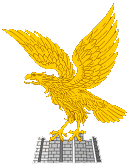
| |
| Friuli-Venezia Giulia' | |
|---|---|
| Region coa | 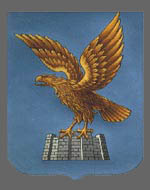
|
| Map | 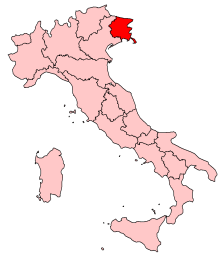
|
| Capital | Trieste |
| Area | 7856 |
| Area source | |
| Area rank | 17th |
| Area percent | 2.6 |
| Population | 1222061 |
| Pop rank | 15th |
| Pop percent | 2.0 |
| Pop ref | |
| Pop date | 2007-12-31 |
| GDP | 34.3 |
| GDP year | 2006 |
| GDP percent | |
| Website | www.regione.fvg.it |
| Leader title | |
| Leader | Renzo Tondo |
| Leader party | PdL |
| NUTS | ITD |
Friuli-Venezia Giulia (Friulian: Friûl-Vignesie Julie, Template:Lang-de, Template:Lang-sl, Template:Lang-vec) is one of the twenty regions of Italy, and one of five autonomous regions with special statute. The capital is Trieste. It has an area of 7,856 km² and about 1.2 million inhabitants. A natural opening to the sea for many Central European countries, the region is traversed by the major transport routes between the east and west of southern Europe. It encompasses two historical regions, each own with its distinct identity: Friuli and Venezia Giulia.
Geography
Friuli-Venezia Giulia is Italy's most North-eastern region. It covers an area of 7,856 km2 and is the fifth smallest region of the country. It borders Austria to the North and Slovenia to the East; to the South it faces the Adriatic Sea.
Despite its relatively small dimension, the region boasts a wide variety of climates and landscapes (as well as cultures and traditions). 42.5% of its surface is made up by mountains, 19.3% by hills and the remaining 38.2% by the plains situated in the central areas and along the coast.

Morphologically the region can be divided into four main areas:
- the mountainous area in the north: this part of the region includes Carnia and the ending section of the Alps (Carnic Alps and Julian Alps), of which the highest peaks exceed 2,700 m above sea level (Jôf di Montasio 2,754 m.). Its landscapes are characterised by vast pine forests and pastures, mountain lakes (e.g. Sauris and Barcis) and numerous streams and small rivers descending from the mountains. The area is also known for its tourist destinations, especially during the winter season; - the hilly area, situated to the south of the mountains and along the central section of the border with Slovenia. The main product of agriculture in this area is definitely wine, whose quality, especially the white, is known worldwide; - the central and upper plains are characterised by poor, arid and permeable soil which, however, has been made fertile with an extensive irrigation system and through the adoption of new intensive farming techniques. In this part of the region most of the agricultural activities are concentrated; - the coastal area can be divided in two sections, separated by the mouth of the river Isonzo. To the West, the low, sandy coast, with numerous tourist resorts and the lagoons of Grado and Marano Lagunare; to the East the coastline becomes high and rocky all the way to Trieste and Muggia. Along this part of the coast the Carso plateau is situated. It extends over the provinces of Trieste and Gorizia, at an average altitude of 400 to 600 metres above sea level and is characterised by very specific geological features and phenomena.
The rivers of the region flow from the North and from Slovenia into the Adriatic. The two main rivers are the Tagliamento, which divides the Alps from the less high Alpine foothills, and the Isonzo. Another river of interest is the Timavo, which flows underground for 38 km from Slovenia and resurfaces near its mouth in Duino.
The region Friuli-Venezia Giulia has a temperate climate. However, due to the diversity of its territory, it varies considerably from one area to another. Protected by the Alps on the northern side, the region is exposed to air masses from the East and the West. The region is also open to the winds from the sea (scirocco), bringing with them heavy rainfalls. Along the coast the climate is mild and pleasant (Triest records the smallest temperature differences between winter and summer and between day and night), but becomes more continental in the mountain area, where, in some locations, the coldest winter temperatures in Italy can often be found. The Kras plateau has its own weather and climate, influenced, mostly during autumn and winter, by masses of cold air coming from the North-East. These generate a very special feature of the local climate: the north-easterly wind Bora, which blows over the Gulf of Trieste with gusts occasionally exceeding speeds of 150 km/h.
History
- Main articles: History of Friuli and History of Venezia Giulia
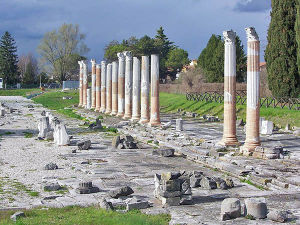
The traces of a common "Roman origin" are quite visible over all the territory, and the unifying element of the two parts is the X Regio Venetia et Histria, with its capital at Aquileia in the Augustan period. Starting from the Longobard settlements (6th century), the historical paths diverge and become particularized: Cividale del Friuli – the Roman Forum Iulii (from which the name Friuli comes) – became the capital of the first Longobard Dukedom in Italy; the [Franks], arriving a couple of centuries later, favoured the growth of the church of Aquileia; the patriarchal feudal state, which was created in 1077, held both religious and temporal power and this was extended temporarily even to the east, but already in the 12th century Gorizia had actually become independent and Trieste, along with other coastal towns, organized itself as a free city-state.
It was the Fatherland of Friuli that became Venetian territory in 1420, while Trieste and Gorizia remained under the Austrian Empire. Pordenone was a "corpus separatum", under Austrian influence until 1515, when it fell under the domination of Venice, too. With the peace treaty of Campoformido in 1797, Venetian domination came to an end and Friuli was ceded to Austria. After the period of domination by Napoleon, which affected also Trieste and Gorizia, it again became part of the Austrian Empire and was included in the Lombard-Veneto Kingdom, while Gorizia was merged with the Illyrian Kingdom and Trieste, together with Istria, became part of the Austrian Coastal Region. The enlightened policy of the Austrian-Hungarian Empire in the 18th and 19th centuries encouraged an extraordinary economic flourishing, making Trieste the empire’s port. The fortunate outcome of the war of independence brought Friuli alone into the unified Kingdom of Italy. After the First World War, in which this region was a main theatre of operations, and suffered very serious damage and loss of lives, the fates of these border lands were again united, although Venezia Giulia, in particular, underwent very painful experiences due to the explosion of contradictions regarding the borders.
The Second World War, once again very dearly paid for, led to the Anglo-American Administration in Trieste until the border was fixed with the Memorandum of London in 1954. When Trieste was reunited with Italy, the Autonomous Region of Friuli Venezia Giulia could finally be established. The Italian Constitution assigns it the status of Region with a Special Statute, together with four other Italian regions. However, Friuli Venezia Giulia obtained administrative autonomy and the special statute only in 1963. The reasons for this "constitutional delay" are interwoven with the international problems of the second postwar period and with those deriving from the region’s "diversity" – the different historical, ethnic, and linguistic components that go to make up this area. In 1975 the Treaty of Osimo was signed in Osimo, definitively dividing the former Free Territory of Trieste between Italy and Yugoslavia.
Economy

The economy of Friuli-Venezia Giulia is one of the most developed in the country. Its core is based on small- and middle-size enterprises (the so-called 'North-East model'), on specialised farming and on high-quality tourism with a significant inclination towards exports.
Agriculture and farming maintain an essential role in the economy of the region and employed in 2001 around 95,000 persons. Its high quality products are exported not only within the country and Europe (fruit and vegetable, cheese) but have become known worldwide for their quality (cured ham and wines, especially white ones). Noteworthy is also the production of soy (third producer in Italy with more than 37,000 hectares cultivated in 2000) and timber production in Carnia.
As mentioned above, the economy of the region is based on a widespread mosaic of small and medium-size enterprises; of particular importance are the four industrial districts where a multitude of such highly specialised enterprises are concentrated. These districts are centred around the towns of Manzano (accounting for the production of 30% of chairs in the world), San Daniele del Friuli (cured ham), Maniago (knives) and Brugnera (furniture). A number of large enterprises are also present in the region in both the industry and services sector. Some of these companies are world-leaders in their relevant sectors; such are Fincantieri (based in Trieste and in Monfalcone) for the construction of the world's largest cruise ships, Zanussi-Electrolux (Pordenone) in the production of electrical appliances and Assicurazioni Generali in Trieste, one of the leading insurance companies in the world.
Again, in the services sector the city of Trieste plays a leading role (with knock-on effects on the other provincial capitals); it is in fact here that activities such as the regional government, large banking and insurance companies are concentrated. With its commercial Free Port, Trieste also plays an essential role in the trade sector: special custom regulations ensure exclusive financial conditions to operators. The Port of Trieste is today the most important centre worldwide for the trade of coffee and plays a strategic key role in trade with northern and eastern Europe.
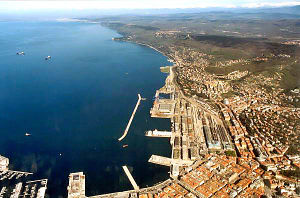
Although small in size, Friuli-Venezia Giulia has always been 'in the centre of Europe' and has played an important role in connecting Italy (and the Mediterranean) to Central and Eastern Europe. Its role will become even more strategic as a logistical platform with the imminent enlargement of the European Union. Hence the importance of the infrastructure network of the region, which can today be considered first rate in quality and diversity. The motorway network consists of more than 200 km that run from North to South and from West to East, perfectly connecting the region to Austria and Slovenia. The railway network consists of around 500 km of track, with the two twin-line 'backbones' Venice-Trieste and Trieste-Udine-Tarvisio-Austria. The motorway and railway networks are linked to the ports of Trieste, Monfalcone and Porto Nogaro, the three most northerly ports of the Mediterranean. Trieste, in particular, has a free port for goods since 1719. It is the Italian port with the greatest capacity for covered storage, with a surface area of more than 2 million square meters and 70 km of rail tracks. Intermodality is guaranteed by the [Cervignano] terminal, in operation since 1988, to serve the increasing commercial traffic between Italy and Eastern European countries. Lastly, the regional airport of Ronchi dei Legionari is situated 30 km from Trieste and 40 km from Udine and is closely connected to the motorway and railway networks. The airport offers regular national and international flights including destinations in Eastern Europe. The region is now placing much of its hopes for future economic development in the construction of a high speed European Transport Corridor n° V connecting Lion, Turin, Venice, Trieste, Ljubljiana, Budapest and Kiev, so as to improve the traffic of goods and services with new EU partners.
Demographics
Template:Historical populations
Population density is lower than the national average; in 2008 it was in fact equal to 157.5 inhabitants per km2 (compared to 198.8 for Italy as a whole). However, density varies from a minimum of 106 inhabitants per km2 in the province of Udine to a maximum of 1,144 inhabitants per km2 in the province of Trieste. The negative natural balance in the region is partly made up by the positive net migration. To some extent the migratory surplus has in fact offset the downward trend in the population since 1975. In 2008, the resident population with foreign nationality registered in the region accounted to 83,306 persons (6.7% of the total population).
Language
Apart from Italian, the Friulian language is spoken in most of the region — with a few exceptions, most notably Trieste; there is also a sizeable Slovenian and a small German minority.
The Slovenian language is spoken throughout the province of Trieste, as well as in the eastern parts of the provinces of Gorizia and Udine and in the area called Venetian Slovenia, which comprises the Resia Valley and in the upper valleys of the rivers Torre and Natisone, with many villages having both Italian and Slovenian names. The number of Slovenes in the region is 61,000.
The number of native German speakers in Friuli-Venezia Giulia is estimated to be around 2,000. They live in the Val Canale (municipalities of Tarvisio, Malborghetto Valbruna and Pontebba), which is adjacent to Austria, and in the municipality of Sauris and the frazione of Timau (Tischlbong in the local Germanic language) (municipality of Paluzza), which each form a language exclave.
Government and politics
PdL gained 53.8% of Friuli-Venezia Giulia's votes at the Italian general election in 2008. The region's local government, led by President Renzo Tondo, is center-right.
Administrative divisions
Friuli-Venezia Giulia is divided into four provinces:
| Province | Area (km²) | Population | Density (inh./km²) |
|---|---|---|---|
| Province of Gorizia | 466 | 142,392 | 305.5 |
| Province of Pordenone | 2,273 | 311,931 | 137.2 |
| Province of Trieste | 212 | 236,445 | 1,115.3 |
| Province of Udine | 4,905 | 539,224 | 109.9 |
Notable residents or natives
- Ernesto Illy, Cavaliere del Lavoro (Knight of Industry 1994), Chairman illycaffè S.p.A.
- Dino Zoff, football goalkeeper Italy, Juventus.
- Vladimir Bartol, writer.
- Leo Castelli, art dealer.
- Avgust Černigoj, painter.
- Max Fabiani, architect.
- Tarcisio Burgnich, footballer.
- Arturo Malignani, inventor of the incandescent light bulb.
- Claudio Magris, writer.
- Primo Carnera Boxer.
- Ermes di Colorêt (16th century)
- Saint Paulinus II, (c. 750-802), patriarch of Aquileia
- Pietro Zorutti (19th century)
- Pier Paolo Pasolini (20th century)
- Boris Pahor, writer.
- Umberto Saba, poet.
- Italo Svevo, writer.
- Carlo Michelstaedter, philosopher.
- Fabio Capello, football manager.
- Erica Ferluga, economist.
- Ludovico Manin, last Doge of Venice
- Mario Agante, poet
- Dante Spinotti, cinematographer, LA Confidential and Last of the Mohicans
External links
- Official site of the Autonomous Region of Friuli-Venezia Giulia
- fvg.INFO
- Map of Friuli-Venezia Giulia
- Tourism Friuli Venezia Giulia
- Airport of Friuli Venezia Giulia
- La Patrie dal Friûl
- Friulian Meteorological Observatory
| Regions of Italy | ||||
|---|---|---|---|---|
| Abruzzo • Aosta Valley • Apulia • Basilicata • Calabria • Campania • Emilia-Romagna • Friuli-Venezia Giulia • Lazio • Liguria • Lombardy • Marche • Molise • Piedmont • Sardinia • Sicily • Trentino-South Tyrol • Tuscany • Umbria • Veneto | ||||
